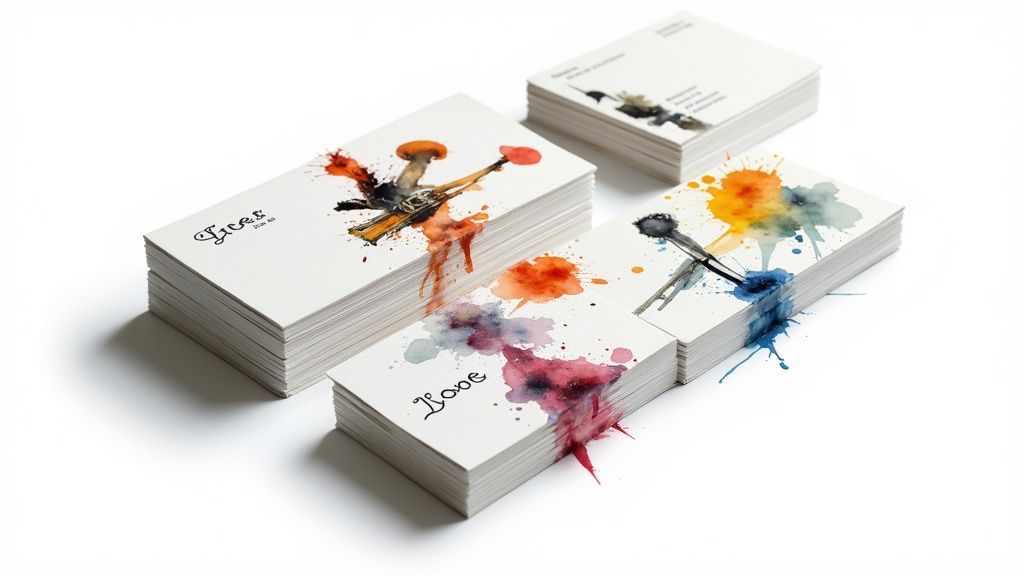Understanding the Power of Brand Style Guides

A brand style guide serves as the core blueprint for your brand identity. It establishes clear standards for everything from logo usage to brand voice, helping maintain a unified brand experience. Think about how jarring it would be if a major soft drink brand suddenly changed its signature colors - this highlights why having clear brand guidelines matters so much.
These guides do more than just document rules - they empower your entire team to create materials that truly reflect your brand's personality. When designers, writers, and marketers all work from the same playbook, it creates a seamless experience that resonates with your audience and builds lasting connections.
The numbers back up the importance of brand consistency. Companies that maintain consistent branding are 3.5 times more visible in the market compared to those with inconsistent brand presentation. This increased visibility comes from applying brand elements uniformly across marketing channels, which helps build trust with customers. Learn more about brand guidelines here: Venngage Brand Guidelines Templates
Why Brand Style Guides Are Essential
As your business grows, keeping your brand consistent becomes more complex. A well-crafted style guide gives everyone clear direction on representing your brand properly. This prevents mixed messages and keeps your brand identity strong. Having these guidelines in place also speeds up content creation since teams don't have to guess about brand standards.
Key Benefits of Using a Brand Style Guide Template
- Saves Time and Resources: Start with a proven structure instead of building guidelines from scratch
- Ensures Consistency: Templates help you cover all essential brand elements systematically
- Easy to Update: Make changes to your guidelines smoothly as your brand grows
Read also: How to Master Brand Identity for Publishers
A brand style guide template gives you the foundation for building a strong, memorable brand presence. By starting with a tested framework, you can focus on crafting guidelines that capture your unique brand personality and help your business stand out.
Essential Components of a Brand Style Guide

A brand style guide serves as the foundation of your visual identity. It helps maintain consistency across all platforms and builds recognition with your audience. Let's explore the key elements that make up an effective style guide.
Logo Specifications
Your logo represents the face of your brand. The style guide needs clear rules about its usage, including all variations (full-color, black and white, icon-only), spacing requirements, and examples of incorrect usage. For instance, defining minimum size prevents tiny, unreadable logos, while showing what not to do helps protect your brand's appearance.
Color Palette
Colors create memorable brand experiences. Your guide should list both primary and secondary colors with their exact codes (hex, RGB, Pantone). Include specific guidelines for using colors in different contexts like backgrounds, text, and buttons. This detail ensures your brand looks the same everywhere.
Typography Guidelines
The right fonts shape how people read and perceive your brand. Your guide should specify primary and secondary typefaces, along with exact sizes, weights, and spacing for headlines, body text, and captions. Think of it like sheet music - these rules help everyone hit the right notes when creating content.
Image Guidelines
Visual style goes beyond logos and colors. Your guide needs clear rules about photos and illustrations. This includes preferred image styles, editing techniques, and quality standards. For example, if authenticity matters to your brand, you might specify using natural, unposed photos rather than staged shots.
Brand Voice and Tone
A brand's personality shows through its words. Your guide should define how your brand speaks - from writing style to word choice to overall tone. Are you casual and friendly or professional and authoritative? Clear voice guidelines help keep messaging consistent from social posts to website copy.
By including all these elements, your style guide becomes a practical tool for building a strong, recognizable brand. It helps teams create consistent content while maintaining your brand's core identity across every touchpoint. Want to see great examples? Check out these Brand Style Guide Examples.
Customizing Your Brand Style Guide Template

A brand style guide template gives you a foundation to build on. The key is making it your own by thoughtfully adapting it to showcase what makes your brand special. This goes beyond simply filling in sections - it's about creating a practical tool that captures and communicates your brand's essence.
Adapting Standard Elements
While templates typically include basic sections for logos, colors, and fonts, effective guides dig deeper. Take your logo section - rather than just showing variations, explain the story and feelings it should convey. Help your team grasp the meaning behind the design so they can use it with purpose. For colors, move past hex codes to describe the emotions and messages each shade represents. This context helps maintain consistent and meaningful visual branding.
Incorporating Brand Voice and Values
Your brand's personality and principles should shine through in every section. If environmental responsibility matters to your brand, provide specific guidance on using eco-conscious imagery and language in communications. When visuals and messaging align with core values, it creates an authentic brand experience that resonates with audiences.
Adding Custom Sections
Sometimes standard template sections won't cover everything you need. Feel free to add sections unique to your industry or workflow. For example, video production teams might need detailed guidelines on aspect ratios and motion graphics. Photography-heavy brands could include a dedicated section on photo styles and techniques. These targeted additions make your brand style guide truly useful for daily work.
Creating Clear Information Hierarchy
Organize your guide with a logical structure that makes finding information quick and easy. Use clear headings, subheadings and bullet points to break up content. When team members can quickly locate the exact guidelines they need, it leads to more consistent brand execution and fewer bottlenecks.
By thoughtfully customizing a brand style guide template, you create a dynamic resource that gives your team clear direction for maintaining a strong, recognizable brand presence. The time invested in making it your own pays off in more cohesive and impactful brand communications.
Implementing Your Brand Guidelines Effectively

A brand style guide is just the beginning. The real work comes in helping your team actually use it day-to-day. Your guidelines need to be clear, accessible, and easy to apply. Let's explore proven approaches for rolling out brand guidelines successfully.
Securing Team Buy-In
Getting your team on board starts with explaining the "why." Show them how consistent branding makes their jobs easier and strengthens brand recognition. For example, point out how unified social media visuals lead to better engagement metrics. When key team members help shape the guidelines, they're more likely to champion them.
Training and Education
Good training helps teams understand and apply the guidelines correctly. Consider running hands-on workshops that walk through the guide and address common questions. This is especially important for remote workers and external partners who can't pop by your desk for help.
Establishing Clear Processes
Make it simple to follow guidelines by building them into existing workflows. Provide ready-made templates with the right fonts, colors and logo usage built in. This helps teams create on-brand materials quickly. A simple checklist can help ensure materials meet brand standards before going live.
Handling Implementation Challenges
Change often faces some resistance. Address concerns openly and provide ongoing support. When team members worry guidelines will limit creativity, show how they actually provide helpful creative direction while maintaining brand consistency. For large organizations, start with pilot teams to gather feedback before wider rollout.
Practical Tools and Techniques
Keep your guidelines easily accessible in a central online location that everyone can reach. Create quick reference guides for common brand elements like logos and colors. This helps team members find key information fast without digging through the full document. A well-implemented brand style guide gives your brand a strong foundation for consistent communication across all channels.
Digital Integration and Asset Management
Brand style guides need to live online where teams can easily access them. Digital integration and asset management ensures everyone works from the latest version, not outdated PDFs or printed documents collecting dust. A central digital home for your brand guidelines keeps teams aligned and prevents confusion from old versions floating around.
Choosing the Right Platform
The platform you choose for hosting your brand guidelines and assets makes a big difference. Key features to look for include version control to track changes and prevent accidental edits, easy search functionality to quickly find specific files, and user permissions to manage who can access and update different sections. These capabilities help teams work efficiently while maintaining brand consistency.
Organizing Your Digital Assets
Good organization is essential for finding what you need quickly. Create clear folder structures grouped by asset type (logos, images, videos) or campaign. Use consistent naming conventions - for example, "ProjectName_AssetType_Date_Version" helps everyone identify the right files immediately. Add tags, keywords and visual previews to make browsing and searching even easier.
The Power of Cloud-Based Systems
Cloud storage provides major benefits for brand asset management. Teams can access files from anywhere with internet, automatic backups protect against data loss, and storage space grows with your needs without requiring new hardware. The flexibility of cloud systems helps distributed teams stay synchronized while keeping costs manageable. You might be interested in: How to Master Digital Asset Management for Business Transformation
Real-World Examples and Impact
Leading brands rely on digital asset management to maintain consistency. For instance, major retailers use cloud platforms to distribute approved product photos and marketing materials to stores worldwide, creating a unified experience across locations. This level of control over brand assets directly improves how consistently customers experience the brand both online and in stores. When teams have easy access to the right files and guidelines, they can reliably deliver the brand promise.
Measuring and Maintaining Brand Consistency
Having a brand style guide is just the first step - you need to continuously track its effectiveness and keep it current. When guidelines become outdated, they can actually harm your brand instead of helping it.
Establishing Key Performance Indicators (KPIs)
To gauge if your brand style guide is working, you need clear Key Performance Indicators (KPIs). Track metrics like how often teams download approved brand assets from your digital asset management system. Monitor the visual consistency across your website and social channels. Look at website traffic and social engagement to see how consistent branding affects audience interaction.
Conducting Brand Audits
Think of a brand audit like a checkup for your visual identity. Review all your materials - from marketing pieces to online presence - to ensure they match your guidelines. Document any inconsistencies you find, group them by type, and figure out what's causing them. This gives you practical insights to improve your guidelines and training.
Gathering Stakeholder Feedback
Your team members use these guidelines daily - their input matters. Run surveys and focus groups to learn what's working and what needs adjustment across departments. This inclusive process helps keep your guide practical and user-friendly. For example, your sales team might tell you the current image rules don't work well for their client presentations.
Updating Your Brand Style Guide
Guidelines need to grow with your brand, but changes should be strategic and clearly communicated. When updating the guide, document what changed and why, then train everyone on the new rules. This reduces confusion and keeps your brand fresh. Learn more in our article about How to Master SEO for Your Content.
Using Data-Driven Insights
Hard data shows how people view your brand and whether teams follow the guidelines correctly. Study your website stats, social media metrics, and customer feedback to spot areas of strong and weak brand consistency. Let this data guide your decisions about future guide updates.
Keeping your brand consistent takes ongoing work. These strategies help ensure your brand stays recognizable and impactful everywhere it appears.
Want to create video content that matches your brand perfectly? Try Aeon, a video platform built for publishers. Our AI helps you make engaging, on-brand videos efficiently. Visit https://www.project-aeon.com to learn more.